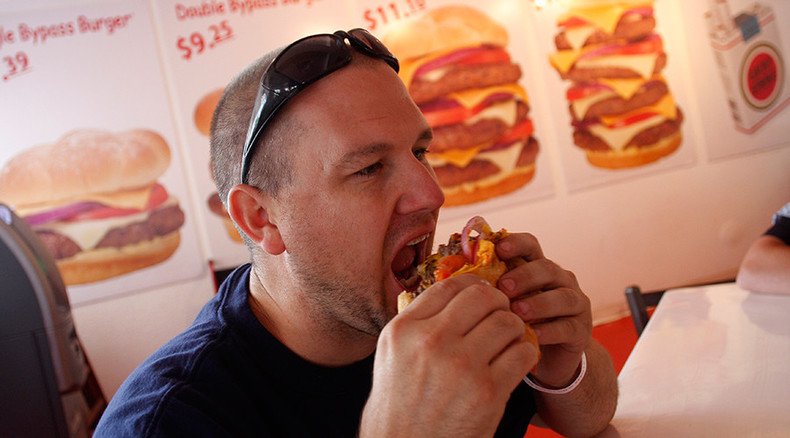#GMO: To meat or not to meat?

We are putting ourselves at risk by consuming meat - not because of the intrinsic carcinogenicity of the product - but because of the way it’s raised, says Sayer Ji, advisor to the National Health Federation and Steering Committee of the Global GMO Free Coalition.
RT: What do you think about meat corporations? Do they use GMO products to feed their animals and is it safe to humans? Do we know for sure?
Sayer Ji: When it comes to the meat on the market today globally, primarily in the US market, we can say that it is almost exclusively contaminated and or containing genetically modified ingredients, which include, of course, the now acknowledged probable carcinogen ‘Roundup’ contaminating that feed. So, what happens is as you go up the food chain and the animals consume the GMO feed, they do bioconcentrate these toxicants which are only going to increase the likelihood of them contributing to cancer. So, clearly they are not safe; even the World Health Organization acknowledges this. So, it is no longer a question that we are putting ourselves at risk by consuming meat not because necessarily of the intrinsic carcinogenicity of the meat itself, but the way we are raising it.
RT: Why do you believe WHO haven't included any word of GMO in their report on cancer? Why haven't they studied that aspect of concentrated animal feeding operation for instance?
SJ: There has been some criticism over the cancer research arm of the WHO, which released this recent report on meat and cancer risk in that they have conflict of interest. So in order to sort of convince folks that the issues aren’t clearly poisoning which is really the problem with the GM-based agricultural system is that it relies on using a biocide which is 'Roundup', primarily, glyphosate. And so anything that is exposed to it will have adverse effects. So, in many ways this report generates the appearance of a credible agency trying to protect public health where, on the other hand, we know that what isn’t being said is just as meaningful as what is being said.
#VIRAL: Bacon, hot dogs, processed meats cause cancer – WHO report https://t.co/OFOhC7l4Vkpic.twitter.com/nmXjDU35YF
— RT (@RT_com) October 27, 2015RT: Most of the studies demonstrating that GM foods are as nutritional and safe as those obtained by conventional breeding have been performed by biotechnology companies or associates which are also responsible of commercializing these GM plants. Is there anything suspicious about that?
SJ: Absolutely, we already have the profound problem of publication bias, which is anyone who is putting massive amounts of capital into publishing any type of research on the benefits of, say, a product on the market, they choose to publish the research and if it is a bad finding they don’t have to publish it. And so we have that problem. But certainly if the primary funder of the research demonstrating so-called substantial equivalence between conventional and GMO organisms, obviously, that conflict of interest speaks to malfeasance.
Dr. Sheldon Krimsky, Lenore Stern Professor of Humanities and Social Sciences in the Department of Urban & Environmental Policy & Planning and adjunct professor of public health and community medicine at Tufts University comments on the GMO products: “Most of the soybeans in the US and that are exported to Europe are genetically modified. And about 50 percent of the soybeans that are exported are used in animal feed. So that both in Europe and the US a significant amount of the soybeans is genetically modified [GM]. The Europeans don’t use as much GM corn to feed their animals, but we do in the US use a significant amount of GM corn in the animal feed. So, those are the most significant GM crops that are used to feed animals – corn and soybeans.
We know very little about consuming animals that have been fed GM crops. Some studies cannot find any traces of GM plants in the animals themselves. But the kinds of studies that are done are usually animal-feeding studies. So, they feed the animal GM corn or GM soybean and then they evaluate whether there is any difference between the animals that are fed GM crops and the animals that are fed non-GM crops. So, that is the kinds of studies that are done. But there are really not any studies that look at what happens when humans eat meat from animals that are fed GM crops. And in the animal studies with the animal are fed directly GM crops there is several dozen studies which show adverse effects...”
RT: “Red and processed meat are among 940 substances reviewed by IARC found to pose some level of theoretical ‘hazard’,” said Barry Carpenter, NAMI president. Only one substance, a chemical in yoga pants, has been declared by IARC not to cause cancer. Would you agree with that statement?
LISTEN MORE:
SJ: It is remarkably ridiculous. When you look at the tens of thousands of chemicals that have been released after the beginning of the industrial revolution in the 1880s, every single one of them has not had thorough toxicological risk assessment. So, there is this illusion again generated by the WHO and IARC which is that there is this small list - and yes, meat is on the list – but that is sort of smoke-and-mirror. The reality is: clearly avoid toxicant exposure, chemicals and try to live a natural sustainable lifestyle with whole foods and organic foods whenever possible.
Bacon, ham, sausage cause #Cancer and on same threat list as cigarettes
#FreeBacon
https://t.co/XGoxB4riIg
— IN THE NOW (@INTHENOWRT) October 26, 2015The statements, views and opinions expressed in this column are solely those of the author and do not necessarily represent those of RT.












